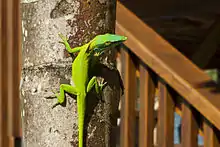Anolis allisoni
Anolis allisoni, also known commonly as Allison's anole or the blue-headed anole, is a species of lizard in the family Dactyloidae. The species is endemic to Cuba (except the west and the far southeast), the Bay Islands and Cayos Cochinos off the mainland of Honduras, and Half Moon Caye off the mainland of Belize.[1][2] There is also a single doubtful record from Cozumel, Mexico.[2] This diurnal species is commonly seen on palm trunks, and it feeds on invertebrates.[2] It is among the relatively few anole species in which females may lay their eggs together, forming a communal nest.[3]
| Allison's anole | |
|---|---|
 | |
 | |
| male above, female below | |
| Scientific classification | |
| Kingdom: | Animalia |
| Phylum: | Chordata |
| Class: | Reptilia |
| Order: | Squamata |
| Suborder: | Iguania |
| Family: | Dactyloidae |
| Genus: | Anolis |
| Species: | A. allisoni |
| Binomial name | |
| Anolis allisoni Barbour, 1928 | |
Etymology
The specific name, allisoni, is in honor of American philanthropist Mr. Allison Vincent Armour.[4]
Taxonomy
Anolis allisoni is part of the carolinensis group of anoles, a clade of mid-sized trunk-crown anoles thought to have originated in Cuba. It is very closely related to other anoles of this group such as the American green anole, Anolis carolinensis, and its Cuban "cousin" Anolis porcatus.
Description

In terms of colour and morphology, Allison's anole is superficially similar to the better-known American green anole. While females are overall green with paler underparts, similar to the green anole, males have a reddish-pink dewlap, and typically have bright blue heads, forelegs, and frontal half of the body (in males from Honduras, only parts of the head are blue with the remaining green).[2][5] In all individuals the throat is usually white. Both sexes are able to rapidly change their colour to brown.[2] Females reach about 7.5 cm (3 in) in snout-vent length and males about 10 cm (4 in).[6] It is one of the larger species in the carolinensis species group. Allison's anole is a typical trunk-crown anole. Like other anoles in the carolinensis group, it has a large, conspicuously triangular-shaped head, and males have a prominent nuchal crest. This lizard has large subdigital toepads, which help facilitate climbing and clinging to vertical surfaces.
Distribution and habitat
Distribution
This anole is believed to have originated on Cuba but has since spread to Honduras and Half Moon Caye. This migration is believed to have occurred long ago as the different populations on these three locations display sufficient phenotypical and genetic differentiation to be considered for subspecies status. Few specimens have been identified in Mexican Banco Chinchorro island.
Habitat
Anolis allisoni is a trunk-crown anole, meaning that it is commonly found in the canopy and on the upper trunk of tall trees. It is commonly found up to 1.5 m (4.9 ft) off the ground. This anole has evolved large subdigital toepads, compared to most other anoles, and this adaptations helps it to cling to vertical surfaces such as the trunks of trees. This lizard is most commonly seen on coconut palm trees. Before coconuts were introduced to the island of Half Moon Caye the lizard probably occupied a similar niche in the crowns of salt water palmettos (Thrinax radiata), which was exterminated from the island in 1982. It has been suggested that this plant be reintroduced to the island to provide habitat for the lizards, especially since the coconut palm population on Half Moon Caye has been gradually declining. In more urban areas this lizard may be commonly be seen on walls and other man-made structures. It is a common sight on the island of Cuba, where its population is largest.
See also
References
- Köhler G (2000). Reptilien und Amphibien Mittelamerikas. Band 1: Krokodile, Schildkröten, Echsen. Offenbach, Germany: Herpeton Verlag. 158 pp.
ISBN 3-9806214-0-5 - Lee JC (2000). A Field Guide to the Amphibians and Reptiles of the Maya World: The Lowlands of Mexico, Northern Guatemala, and Belize. Ithaca, New York: Cornell University Press. 416 pp. ISBN 0-8014-3624-9
- Domínguez M, Sanz A, Chávez J, Almaguer N (2010). "Cyclical Reproduction in Females of the Cuban Lizard Anolis lucius (Polychrotidae)". Herpetologica. 66 (4): 443–450.CS1 maint: multiple names: authors list (link)
- Beolens, Bo; Watkins, Michael; Grayson, Michael (2011). The Eponym Dictionary of Reptiles. Baltimore: Johns Hopkins University Press. xiii + 296 pp. ISBN 978-1-4214-0135-5. (Anolis allisoni, p. 6; "Allison Vincent Armour", p. 11).
- Bedrossian RB (21 April 2014). "Anolis allisoni: La lagartija de cabeza azul ". ["Anolis allisoni: The blue-headed lizard"]. Serie Reptiles y anfibios de Centroamérica. Retrieved 15 March 2018.
- Thomas GH, Meiri S, Phillimore AB (2009). "Body Size Diversification in Anolis: Novel Environment and Island Effects". Evolution 63 (8): 2017-2030.
Further reading
- Barbour T (1928). "Reptiles from the Bay Islands". Proc. New England Zoöl. Club 10: 55-61. (Anolis allisoni, new species, pp. 58–59).
- Schwartz A, Thomas R (1975). A Check-list of West Indian Amphibians and Reptiles. Carnegie Museum of Natural History Special Publication No. 1. Pittsburgh, Pennsylvania: Carnegie Museum of Natural History. 216 pp. (Anolis allisoni, p. 66).
External links
| Wikimedia Commons has media related to Anolis allisoni. |
- Lowe, Chelsea (2007). Photo of mating pair of Allison's Anole. Flickr.
